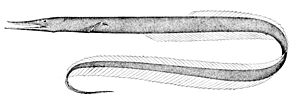Bean's sawtooth eel facts for kids
Quick facts for kids Bean's sawtooth eel |
|
|---|---|
 |
|
| Scientific classification | |
| Synonyms | |
|
The Bean's sawtooth eel (scientific name: Serrivomer beanii) is a fascinating deep-sea eel. It's also known by other names like the longfin sawpalate or sawtooth eel. This unique fish belongs to a family of eels called Nemichthyidae, often called snipe eels.
Scientists Theodore Gill and John A. Ryder first described this eel in 1883. It lives deep in the ocean, far from the surface. You can find it in many parts of the world, including the Atlantic, Indian, and Western Pacific Oceans. This includes places like Iceland, South Africa, Réunion, and Australia.
The Bean's sawtooth eel lives at depths from the surface down to almost 6,000 meters (about 3.7 miles!). It prefers to live alone. At night, it swims closer to the surface to find food. This eel can grow quite large for its kind. Males can reach up to 80 centimeters (about 31 inches) long. This makes it the biggest known sawtooth eel!
The name "beanii" was given to honor an American fish expert, Tarleton Hoffman Bean. This eel mostly eats small creatures that live on the ocean floor, like shrimps. It also eats other fish, such as small oreos and lanternfish. Sometimes, young Bean's sawtooth eels might become food for the Warty oreo. People don't usually fish for the Bean's sawtooth eel, so it's not important for fishing businesses.
What Does the Bean's Sawtooth Eel Look Like?
The Bean's sawtooth eel has a very special look. Like other sawtooth eels, it has long, thin jaws. These jaws are filled with teeth that curve backward, like tiny hooks. These teeth help the eel grab and hold onto its prey, even big ones!
Its skin is a pale, shiny blue color. It's very delicate and doesn't have scales. If you bring this eel to the surface, its skin can become clear and jelly-like.
This eel doesn't have tail fins or pelvic fins (the ones usually on the belly). Its pectoral fins (side fins) are small and curved. The fins on its back (dorsal fin) and belly (anal fin) are joined together near its tail. The anal fin is longer than the dorsal fin. All its fins are clear, like glass, and don't have any hard spines.
How Does the Bean's Sawtooth Eel Live?
The Bean's sawtooth eel has an interesting daily routine. During the day, it stays in the very deep, dark parts of the ocean. But when night comes, it starts to swim upwards. This is called vertical migration. It moves closer to the surface to hunt for food.
Its diet includes a variety of ocean creatures. It eats shrimps, lanternfish, smaller eels, and even squid. It also hunts for flashlight fishes, which are fish that can make their own light. This hunting strategy helps it find enough food in the vast ocean.

